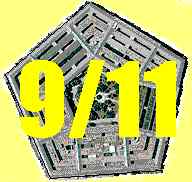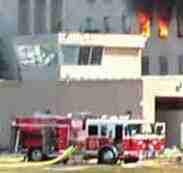

 Heliport
Heliport| sitemap | home | ||||
| Pentagon missile attack 9/11? | F77 home 2 3 4 5 6 7 8 9 10 11 12 13 14 15 16 17 18 19 20 21 22 23 24 25 26 27 28 29 30 31 alpha index |

|
Passenges
|
||
 Heliport Heliport |
9/11 Commission and | ||||
| 9/11 Investigations
|
|||||
911 Commission Report excerpts
|
|
| 911 Commission Report, copy of text on pages 311-315 | Notes |
| "If it had happened on any other day,the disaster at the Pentagon would be remembered as a singular challenge ........... efforts are apparent when we analyze the response at the Pentagon. The emergency response at the Pentagon represented a mix of local, state, and federal jurisdictions and was generally effective. It overcame the inherent complications of a response across jurisdictions because the Incident Command System, a formalized management structure for emergency response, was in place in the National Capital Region on 9/11.190 Because of the nature of the event —a plane crash, fire, and partial building collapse —the Arlington County Fire Department served as incident commander. Different agencies had different roles. The incident required a major rescue, fire, and medical response from Arlington County at the U.S. military ’s headquarters —a facility under the control of the secretary of defense. Since it was a terrorist attack, the Department of Justice was the lead federal agency in charge (with authority delegated to the FBI for operational response). Additionally, the terrorist attack affected the daily operations and emergency management requirements of Arlington County and all bordering and sur- rounding jurisdictions. At 9:37,the west wall of the Pentagon was hit by hijacked American Air- lines Flight 77,a Boeing 757.The crash caused immediate and catastrophic damage. All 64 people aboard the airliner were killed, as were 125 people inside the Pentagon (70 civilians and 55 military service members). One hundred six people were seriously injured and transported to area hospitals. 192 While no emergency response is flawless, the response to the 9/11 terror= ist attack on the Pentagon was mainly a success for three reasons: first, the strong professional relationships and trust established among emergency responders; second,the adoption of the Incident Command System; and third, the pursuit of a regional approach to response. Many fire and police agencies that responded had extensive prior experience working together on regional events and training exercises. Indeed, at the time preparations were under way at many of these agencies to ensure public safety at the annual meetings of the International Monetary Fund and the World Bank scheduled to be held later that month in Washington,D.C.193 Local, regional, state, and federal agencies immediately responded to the Pentagon attack. In addition to county fire, police, and sheriff ’s departments, the response was assisted by the Metropolitan Washington Airports Authority, Ronald Reagan Washington National Airport Fire Department, Fort Myer Fire Department, the Virginia State Police, the Virginia Department of Emergency Management, the FBI, FEMA, a National Medical Response Team, the Bureau of Alcohol, Tobacco, and Firearms, and numerous military personnel within the Military District of Washington.194 Command was established at 9:41. At the same time, the Arlington County Emergency Communications Center contacted the fire departments of Fair- fax County, Alexandria, and the District of Columbia to request mutual aid. HEROISM AND HORROR 315 The incident command post provided a clear view of and access to the crash site, allowing the incident commander to assess the situation at all times.195 At 9:55,the incident commander ordered an evacuation of the Pentagon impact area because a partial collapse was imminent; it occurred at 9:57,and no first responder was injured.196 At 10:15,the incident commander ordered a full evacuation of the com= mand post because of the warning of an approaching hijacked aircraft passed along by the FBI. This was the first of three evacuations caused by reports of incoming aircraft, and the evacuation order was well communicated and well coordinated.197 Several factors facilitated the response to this incident, and distinguish it from the far more difficult task in NewYork. ........ Yet the Pentagon response encountered difficulties that echo those expe= rienced in NewYork. As the "Arlington County: Action Report "notes, there were significant problems with both self-dispatching and communica= tions: "Organizations, response units, and individuals proceeding on their own initiative directly to an incident site, without the knowledge and permission of the host jurisdiction and the Incident Commander, complicate the exercise of command, increase the risks faced by bonafide responders, and exacerbate the challenge of accountability. "With respect to communications, the report concludes: "Almost all aspects of communications continue to be problematic, from initial notification to tactical operations. Cellular telephones were of little value....Radio channels were initially over-saturated....Pagers seemed to be the most reliable means of notification when available and used, but most firefighters are not issued pagers."199" |
|
|
|
|
|
Emergency responders
|
||
|
||
| Evacuation details after arrival of FBI to attack scene | ||
| source: Institute for Crisis, Disaster and Risk Management original report pages | |
|
4.2.
Activation, Deployment and Initial On-Scene Response
Within
minutes of the crash on Pentagon at 9:43 AM, Battalion Chief
Robert Cornwall of the Arlington County Fire Department (ACFD),
diverted from a call to a fire in nearby Rosslyn, VA, and rushed to the
scene. Upon arrival, he assumed command of the Pentagon crash site. Assistant
ACFD Chief James Schwartz arrived
5 to 10 minutes after the crash. Chief Schwartz assumed Incident Command
(IC) from Chief Cornwall and assigned him to operational supervision of
rescue and evacuation. Approximately 5 minutes after Chief Schwartz
assumed IC, Chris Combs of the FBI Joint Terrorism Task Force arrived on
scene and reported to Chief Schwartz (in accordance with the FRP). Chief
Schwartz and Agent Combs had an established professional relationship from
prior exercises and operations and quickly established a close working
relationship. Incident Command therefore knew very rapidly (about 30
minutes into the response) about the missing jetliner, and the safety
implications for the Pentagon rescue site (the fact that two jets had hit
the WTC complex was not lost on the incident managers at the Pentagon
site). In response, all staff was
evacuated to an area under a highway bridge adjacent to the Pentagon,
including any victims that could be moved (due to problems with
radio penetration of the Pentagon structure, several fire fighters that
were located inside the building and in the courtyard were not notified of
this initial evacuation). All
staff remained under the overpass for about 20 minutes, until it was
determined that the threat had passed (FBI liaisons conveyed the
information on the plane crash in Pennsylvania very quickly). Response
personnel returned to their activities, and the ACFD remained in position
and established the Incident Command Post (ICP) for the remainder of that
day underneath the overpass. Security for the ICP was maintained using
Arlington County SWAT team members. Other officers from the Arlington
County Police Force played a supportive role, assuming charge of traffic
around the Pentagon (in conjunction with Virginia State Police), ordering
the closure of roads surrounding it, helping evacuate the Pentagon and
helping the FBI and the other law enforcement agencies collect evidence
and search for bodies. Fairfax motorcycle officers also reported,
unrequested, outside Arlington police headquarters shortly
|
|
| TOP HOME |
Titan
Systems International
|
| Operation Noble Eagle, Victim ID, FBI top After-Action graphic see Page 14 | ||
| PROGRESSIVE | REFERENCE | CONSERVATIVE* |
|
|
|
| Centex top | ||
| PROGRESSIVE | REFERENCE | CONSERVATIVE* |
|
|
|
| Centex Lee top | ||
| PROGRESSIVE | REFERENCE | CONSERVATIVE* |
|
||
| Titan Systems International top | ||
| PROGRESSIVE | REFERENCE | CONSERVATIVE* |
| Titan Corporation, Titan Systems International, SEC Litigation Release 19107 and see San Francisco EMS and CorpWatch | |
| U.S. SECURITIES AND EXCHANGE
COMMISSION Litigation Release No. 19107 \ March 1, 2005 Accounting and
Auditing Enforcement Release No. 2204 \ March 1, 2005 SECURITIES AND
EXCHANGE COMMISSION v. THE TITAN CORPORATION, Civil Action No. 05-0411 (D.D.C.)
(JR) (filed March 1, 2005) SEC SUES THE TITAN CORPORATION FOR PAYMENTS TO
ELECTION CAMPAIGN OF BENIN PRESIDENT TITAN SETTLES AND AGREES TO PAY A
TOTAL OF MORE THAN $28 MILLION TO SETTLE SEC ACTION AND RELATED CRIMINAL
ACTION TITAN PLEADS GUILTY IN RELATED CRIMINAL ACTION BROUGHT BY THE
UNITED STATES ATTORNEY FOR THE SOUTHERN DISTRICT OF CALIFORNIA AND THE
U.S. DEPARTMENT OF JUSTICE, FRAUD SECTION SEC ALSO ISSUES REPORT OF
INVESTIGATION TO PROVIDE GUIDANCE ON DISCLOSURE CONCERNING MATERIAL
PROVISIONS IN MERGER AND OTHER CONTRACTUAL AGREEMENTS The Securities and
Exchange Commission today announced the filing of a settled enforcement
action in the United States District Court for the District of Columbia
charging The Titan Corporation ("Titan"), a San Diego,
California-based military intelligence and communications company, with
violating the anti-bribery, internal controls and books and records
provisions of the Foreign Corrupt Practices Act ("FCPA").
Simultaneously with the filing of the Commission's complaint, and without
admitting or denying its allegations, Titan consented to the entry of a
final judgment permanently enjoining it from future violations of the FCPA
and requiring it (i) to pay $15.479 million in disgorgement and
prejudgment interest, (ii) to pay a $13 million penalty, which will be
deemed satisfied by Titan's payment of criminal fines of that amount in
parallel proceedings brought by the U.S. Attorney's Office for the
Southern District of California and the U.S. Department of Justice, Fraud
Section, and (iii) to retain an independent consultant to review the
company's FCPA compliance and procedures and to adopt and implement the
consultant's recommendations.
The Commission's complaint alleges that, from 1999 to 2001, Titan paid more than $3.5 million to its agent in Benin, Africa, who was known at the time by Titan to be the President of Benin's business advisor. Titan failed to conduct any meaningful due diligence into the background of its agent either before his retention or thereafter and also failed to ensure that the services alleged to be performed by the agent, and described in his invoices, were in fact provided to Titan. The complaint alleges, in 2001, at the direction of at least one former senior Titan officer based in the United States, Titan funneled approximately $2 million, via its agent in Benin, towards the election campaign of Benin's then-incumbent President. The complaint also alleges that some of these funds were used to reimburse Titan's agent for the purchase to T-shirts adorned with the President's picture and instructions to vote for him in the upcoming election. According to the complaint, Titan made these payments to assist the company in its development of a telecommunications project in Benin and to obtain the Benin government's consent to an increase in the percentage of Titan's project management fees for that project. The complaint alleges that a former senior Titan officer directed that these payments be falsely invoiced by the agent as consulting services and that actual payment of the money be broken into smaller increments and spread out over time. The complaint does not allege that the then-incumbent President knew of the payments. The Commission's complaint also alleges that, from 1999 to 2003, Titan improperly recorded payments in its books and records, directed agents to falsify invoices submitted to Titan, and failed to devise or maintain an effective system of internal controls to prevent or detect other FCPA violations. Despite utilizing over 120 agents and consultants in over 60 countries, Titan never had a formal company-wide FCPA policy, failed to implement an FCPA compliance program, disregarded or circumvented the limited FCPA policies and procedures in effect, failed to maintain sufficient due diligence files on its foreign agents, and failed to have meaningful oversight over its foreign agents. According to the complaint, Titan falsified documents that enabled its agents to under-report local commission payments in Nepal, Bangladesh, and Sri Lanka. In addition, the complaint alleges that Titan falsified documents presented to the United States government by under-reporting payments on equipment exported to Sri Lanka, France and Japan. The complaint also alleges that Titan (i) paid a World Bank Group analyst in cash to assist Titan in its project in Benin, and (ii) paid a Benin government official approximately $14,000 in travel expenses from 1999 to 2001.
|
Without admitting or denying the
allegations in the complaint, Titan has consented to the entry of a final
judgment permanently enjoining it from future violations of Sections 30A,
13(b)(2)(A), 13(b)(2)(B), and 13(b)(5) of the Securities Exchange Act of
1934 ("Exchange Act") and Rule 13b2-1 thereunder. Titan also has
agreed to disgorge $12,620,000, and to pay prejudgment interest thereon in
the amount of $2,859,195.47. Under the terms of the final judgment, Titan
will also retain an independent consultant to review the company's FCPA
compliance and procedures and will adopt and implement the consultant's
recommendations.
Also today the U.S. Attorney's Office for the Southern District of California and the U.S. Department of Justice, Fraud Section filed criminal FCPA charges and a tax charge against Titan, who entered a guilty plea before the Honorable Roger T. Benitez, United States District Judge for the Southern District of California (United States of America v. Titan Corporation, Case No.05cr0314-BEN (S.D. Cal.)). In particular, Titan agreed to plead guilty to one felony count of violating the anti-bribery provisions of the FCPA, one felony count for falsifying the books and records of Titan, and one felony count for violating Title 26 U.S.C. Section 7206(2) and to pay a criminal fine of $13 million. Commission's Report Pursuant to Section 21(a) of the Exchange Act The Commission also today issued a Report of Investigation pursuant to Section 21(a) of the Exchange Act to provide guidance concerning potential liability under the antifraud and proxy provisions of the federal securities laws for publication of materially false or misleading disclosures regarding provisions in merger and other contractual agreements. In its Report, the Commission stated that, on September 15, 2003, Titan became a party to a merger agreement with Lockheed Martin Corporation ("Lockheed") in which Lockheed agreed to acquire Titan, pending certain contingencies. Titan affirmatively represented in that merger agreement that to the knowledge of Titan, neither the company "nor any of its Subsidiaries, nor any director, officer, agent or employee of the Company or any of its Subsidiaries, has … taken any action which would cause the Company or any of its Subsidiaries to be in violation of the FCPA." This representation was publicly disclosed and disseminated by Titan in two places. The proxy statement disclosed the nature of the representation. The merger agreement containing the representation was also appended to Titan's proxy statement, which was filed with the Commission and sent to Titan's shareholders. As the Report highlights, when an issuer makes a public disclosure of information -- via filing a proxy statement or otherwise -- the issuer is required to consider whether additional disclosure is necessary in order to put the information contained in, or otherwise incorporated into that publication, into context so that such information is not misleading. The issuer cannot avoid this disclosure obligation simply because the information published was contained in an agreement or other document not prepared as a disclosure document. The Report is not intended to change the way issuers engage in merger, or other contractual, negotiations or to alter existing diligence obligations or to suggest, absent special circumstances (such as provisions intended to create third party beneficiaries), that provisions such as representations and covenants in such agreements are binding on or intended to benefit persons other than parties thereto. Representations, covenants, or other provisions of an agreement made by an issuer that are not public or disclosed to shareholders are not covered by the scope of this Report. The Commission will consider bringing an enforcement action under Sections 10(b) and 14(a) of the Exchange Act and Rules 10b-5 and 14a-9 thereunder in the future if it determines that the subject matter of representations or other contractual provisions is materially misleading to shareholders because material facts necessary to make that disclosure not misleading are omitted. The Commission acknowledges the assistance in this investigation from the Department of Justice, Fraud Section; the United States Attorney's Office for the Southern District of California; the Federal Bureau of Investigation, San Diego Division; the Internal Revenue Service, Criminal Investigations; and the Department of Defense Inspector General's Office, Defense Criminal Investigative Service. The Commission's investigation is continuing. SEC Complaint in this matter Report of Investigation http://www.sec.gov/litigation/litreleases/lr19107.htm
|
 And see more of NewsFollowUp.com and sitemap
And see more of NewsFollowUp.com and sitemap |

 |
TOP HOME see Summary of Attack Concepts
and NFU stats
1st evacuation ordered at 10:15, AA report, page 35-38, 4 evacuations ordered in 1st 24 hours.